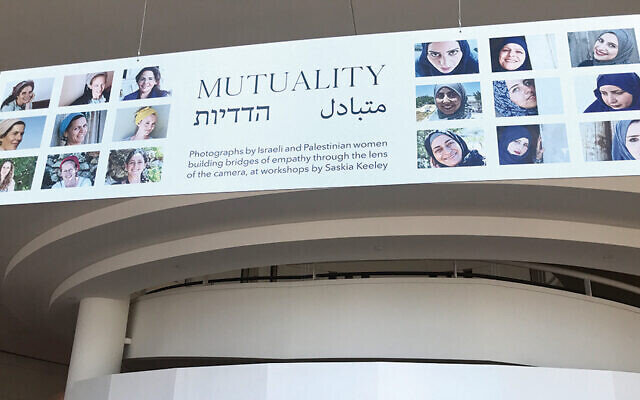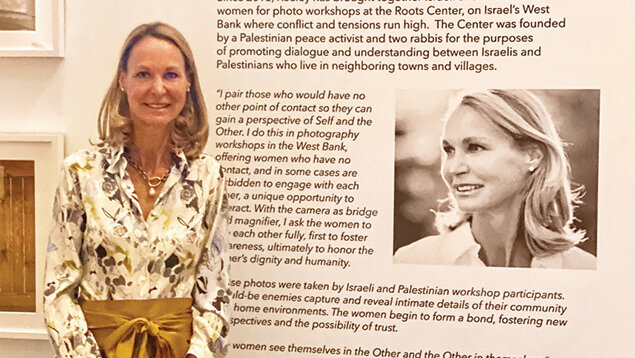Truly Seeing The Other

This article was originally published by Lois Goldrich on November 14, 2019, 09:58 AM on the Jewish Standard website. Click here to read on jewishstandard.timesofisrael.com
Even people well-versed in their chosen professions can learn new things about their fields. Photographer Saskia Keeley’s “aha” moment came when she realized that a camera can help bridge the gaps between disparate groups.
On November 24, at Teaneck’s Temple Emeth, Ms. Keeley — who thinks of herself as a New Yorker after 32 years in the city, but whose Swiss accent still is strong — will use both words and photographs to exemplify her newfound respect for photography as a kind of dialogue. She’s used it to bring Palestinian and Israeli women together.

Saskia Keeley
I spent eight years as a photojournalist for NGOs, documenting their work, I met Rabbi Hanan Schlesinger in Jaipur, India, in 2015 at an NGO conference.
— Ms. Keeley said
Rabbi Schlesinger is one of the founders of Roots/ Shorashim/ Judur — The Palestinian Israeli Grassroots Initiative for Understanding, Nonviolence, and Transformation — and he is its director of international relations. He also is the founder of the American Friends of Roots, a multifaith organization dedicated to supporting the work of the Israeli group.
During their meeting, Rabbi Schlesinger told Ms. Keeley that the organization, founded in 2014, was, for various reasons, having a hard time bringing women into its programs. He asked her if she could work with it, helping to create programs and activities where women from both groups could meet.
“Knowing my work, he asked if I would facilitate a photography workshop,” Ms. Keeley said. (She’s not Jewish, but comes from a Calvinist background, so she’s able to approach both sides equally.) She said yes, took up the challenge, and this summer she held her fifth month-long session for Roots. The first year, she did two workshops back to back, with about 14 women in each group. The maximum number of women who can participate is 20 — she has 20 cameras — “but the sweet spot is 16 or 18,” she said.
The project was advertised on the Israeli side through flyers distributed among settlers’ groups and on the Roots Facebook page. On the Palestinian side, Roots activists in each village identified women in their communities who might be interested. “Now it’s by word of mouth,” Ms. Keeley said.

Saskia Keeley’s workshops for Israeli and Palestinian women have produced remarkable photos on both sides.
Her mission, Ms. Kelley said, “is to create powerful visuals that raise both awareness and hope.” She tries to accomplish her goals in four sessions, that meet throughout June. Every participant receives a camera to keep for the month and is encouraged to take pictures of each other and of their homes and communities.
“They photograph what is perceived as the other, getting closer, getting more comfortable,” Ms. Keeley said. “They keep the cameras until the end of the project, taking pictures of their home environment and family. The photos are reviewed in subsequent sessions, allowing the women to truly see each other.”

The camera is an instrument that teaches people how to see without a camera.
— Dorothea Lange
“There are so many barriers between the Palestinians and Israelis,” Ms. Keeley said. “In the first session, the camera serves as a little bit of a shield. They start photographing each other and can choose any distance, any angle. They don’t need to engage. It’s such a great tool to ease into trust building.”
Looking into precedents for this kind of workshop four years ago, “I found nothing on line where cameras were used as a tool for dialogue and really seeing the other,” she continued. “There wasn’t much being done.” Her work, she said, is “intuitive in some ways. I’ve been a photographer for some time. It’s part of humanity to see each other.”
Looking into precedents for this kind of workshop four years ago, “I found nothing on line where cameras were used as a tool for dialogue and really seeing the other,” she continued. “There wasn’t much being done.” Her work, she said, is “intuitive in some ways. I’ve been a photographer for some time. It’s part of humanity to see each other.”

Ms. Keeley stands in front of a display explaining her workshop.
From the beginning, during their first conversation, Rabbi Schlesinger told her that there was no money and no cameras for the project. “But I was really committed to doing this, and I sensed that good cameras would make a difference, keeping participants motivated,” she said. To obtain the cameras — she ultimately decided to get only Canons — she did fundraising in New York. They’re a crucial part of the program, which depends at least in part on trust. The women know they can keep the cameras for the entire month “and I trust them to bring them back,” Ms. Keeley said. “It’s part of the theme of respect and trust.” In the meantime, Roots can use the 20 cameras for other projects when the annual workshops are done.
Ms. Keeley feels that her project is valuable not just in Israel but in other places where misunderstanding is rife. She has done workshops for formerly incarcerated women; when we spoke, she was in Los Angeles not just to exhibit her West Bank photos but to work with Muslim and Jewish high school students in the area. She also has collaborated with NGOs like the Pico Union Project in Los Angeles, the Women’s Prison Association in New York City, and S.T.R.O.N.G Youth on Long Island.



The workshops have changed her life, Ms. Keeley said. “I transitioned from a journalist working with NGOs to a life where I can connect people.” In fact, she keeps up with some of the participants from long-ago workshops, with them using email or social media. “I’m blown away by what we’ve managed to create — to empower and bring dialogue. This is what I need to offer to conflicted areas.”
Ms. Keeley said that not surprisingly, the photos vary in quality. “You can see quickly that some women have a great eye and really enjoy having a camera. But we always end up with beautiful pictures.”
She has not met resistance from any of the women, though one Jewish participant told her that her neighbors urged her not to be too trusting. “They’re willing participants,” Ms. Keeley said, noting that there is always some nervousness on both sides.
“I’ve learned that the camera is an incredible tool,” she said. “I’ve been so moved by seeing the humanity on both sides, and the willingness of both sides, even with the language barrier. When you truly give your attention to the other, they will show their authentic self. I have an incredible tool in transforming lives and stereotypes and visions.”